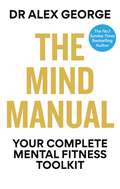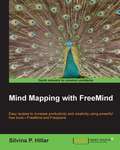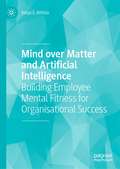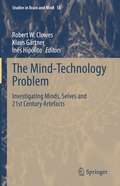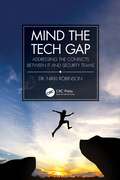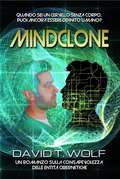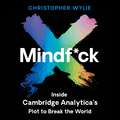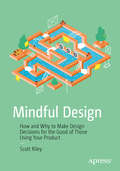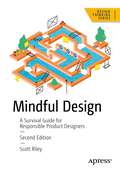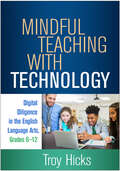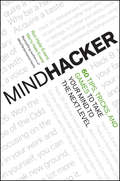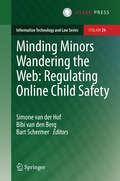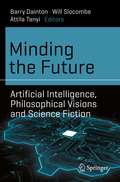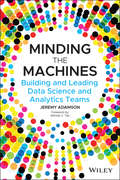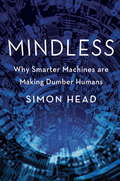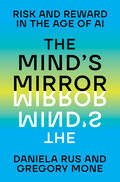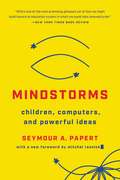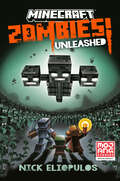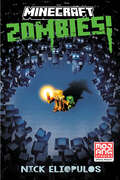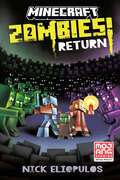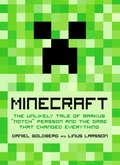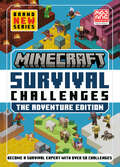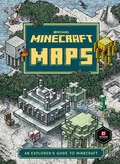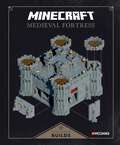- Table View
- List View
The Mind Manual: Mental Fitness Tools for Everyone (Dr Alex George)
by Dr Alex GeorgeYour complete mental fitness toolkit by Dr Alex George'How are you? No really, how are you?'Learn how to assess your mental health today and understand what's normal for you.This is the mental health toolkit that will help you thrive.The Mind Manual is broken down into four parts with each one building on the last. Thegoal is to help you to establish your baseline, to know what peace feels like to you. Andthen to offer advice and tools to help you maintain that as much as possible.Part 1 looks at how to figure out where your baseline is and what normal feels like foryou. It's all about recognising your own needs so that you can best support yourselfwhen issues arise.Part 2 explores the seven universal truths and how they can support you when youmind is telling you lies. These seven truths are: Connection is your superpower; Sleepwill save you; Boundaries are beautiful; Mistakes are a must-have; Stress is the enemy;You are enough; Happiness is an inside job.Part 3 focuses on the foundations of mental fitness and explores the five different areasof life. These include what you eat and drink, how you release stress from your body,how much you move, how to talk out your thoughts and how to approach the medicalside of things.Part 4 is your mental health toolkit, where you'll find a wide range of worksheets andactivity tools to use. These can help while reading the book, but can also be usedregularly in your day-to-day life to check in on how you're coping.
Mind Mapping with FreeMind
by Silvina P. HillarThe book is presented in easy to follow Cookbook recipes covering a wide variety of tasks and applications. The book is for users of FreeMind and FreePlane or new users who would like to explore the world of free mind mapping software. No previous experience is required.
The Mind of Everyday: Combining Individual and Artificial Intelligence
by Petraq Papajorgji Howard MoskovitzThe advent of artificial intelligence (AI) is associated with relevant changes in how we live today. AI has the potential to significantly enhance daily decision-making by providing tailored, data-dependent insights and aiding in intricate analysis. AI-based systems will be around us, helping and advising us in our everyday tasks. However, how well do these systems perform in their quest to "replace" the human brain? A "meter," a procedure for comparing the outcomes obtained by artificial intelligence systems with those obtained by human systems, is necessary to address this issue. This "meter" is Mind Genomics, a new emerging science that delves into the science of how we, as humans, organize and respond to information. To evaluate whether there are differences in the results obtained by AI-based systems and human-based experiments based on 'Outer Psychophysics' were designed and implemented. Thus, four experiments in crucial areas of our lives are selected and cover education, family stress, and environmental and governmental policies. For each area, a Mind Genomic experiment is designed, defining four topics (silos). Then, the elements contained in each of the silos were generated twice, once by humans and then by an AI-based system. Evaluating both systems' performance requires comparing the results obtained by both experiments. The analysis of the study cases is disciplined, rich in scientific tools, and presented with methods. Through a blend of theoretical exploration, case studies, and practical applications, this book aims to inspire readers with the potential of the fusion of Mind Genomics and AI to empower innovation, enhance user experiences, and bring forth a more nuanced understanding of human thought. Whether the reader is a student, a researcher in the field of social and political sciences, or simply curious about the evolving landscape of science and technology, we hope this book will serve as an invitation to explore how we can harmonize human and machine intelligence to better navigate the complex world around us.
Mind over Matter and Artificial Intelligence: Building Employee Mental Fitness for Organisational Success
by Vidya S. AthotaThis book explores mind over matter in a digital age and presents the importance of continued transformation of the mind to promote humane Artificial Intelligence for greater good. In doing so, it focuses on the organizational and managerial practices that are critical in creating an environment that supports mindset and organizational growth. The digital age is significantly impacting employees and organizations and steering billions of people around the world. Artificial Intelligence has created a whole new paradigm with a revolution loftier than all the industrial revolutions and the innovations of the past millennia combined. We are either headed towards restoring humanity back to the “Imago Dei”, where creative powers are unleashed in human freedom, or advocating selective breeding and “survival of the fittest”.
The Mind-Technology Problem: Investigating Minds, Selves and 21st Century Artefacts (Studies in Brain and Mind #18)
by Inês Hipólito Robert W. Clowes Klaus GärtnerThis edited book deepens the engagement between 21st century philosophy of mind and the emerging technologies which are transforming our environment. Many new technologies appear to have important implications for the human mind, the nature of our cognition, our sense of identity and even perhaps what we think human beings are. They prompt questions such as: Would an uploaded mind be 'me'? Does our reliance on smart phones, or wearable gadgets enhance or diminish the human mind? and: How does our deep reliance upon ambient artificial intelligence change the shape of the human mind? Readers will discover the best philosophical analysis of what current and near future 21st technology means for the metaphysics of mind. Important questions are addressed on matters relating to the extended mind and the distributed self. Expert authors explore the role that the ubiquitous smart phone might have in creating new forms of self-knowledge. They consider machine consciousness, brain enhancement and smart ambient technology, and what they can tell us about phenomenal consciousness. While ideas of artificial general intelligence, cognitive enhancements and the smart environment are widely commented on, serious analysis of their philosophical implications is only getting started. These contributions from top scholars are therefore very timely, and are of particular relevance to students and scholars of the philosophy of mind, philosophy of technology, computer science and psychology.
Mind the Tech Gap: Addressing the Conflicts between IT and Security Teams
by Nikki RobinsonIT and cybersecurity teams have had a long-standing battle between functionality and security. But why? To understand where the problem lies, this book will explore the different job functions, goals, relationships, and other factors that may impact how IT and cybersecurity teams interact. With different levels of budget, competing goals, and a history of lack of communication, there is a lot of work to do to bring these teams together. Empathy and emotional intelligence are common phenomena discussed in leadership books, so why not at the practitioner level? Technical teams are constantly juggling projects, engineering tasks, risk management activities, security configurations, remediating audit findings, and the list goes on. Understanding how psychology and human factors engineering practices can improve both IT and cybersecurity teams can positively impact those relationships, as well as strengthen both functionality and security. There is no reason to have these teams at odds or competing for their own team’s mission; align the missions, and align the teams. The goal is to identify the problems in your own team or organization and apply the principles within to improve how teams communicate, collaborate, and compromise. Each organization will have its own unique challenges but following the question guide will help to identify other technical gaps horizontally or vertically.
Mindclone - Quando sei un cervello senza corpo, puoi ancora essere definito umano?: UN ROMANZO SULLA CONSAPEVOLEZZA DELLE ENTITÀ CIBERNETICHE
by Vittorio Rossi David T. WolfMarc Gregorio si risveglia paralizzato. Non riesce più a percepire il proprio corpo. Incidente? Infarto? Qualcuno gli ha fatto un'overdose di Botox? La risposta, scoprirà poi, è molto, molto peggiore. Lui è soltanto una copia di Marc, è un cervello digitale senza un corpo, dotato di tutti i ricordi umani di Marc, ma senza alcun accesso ai piaceri sensuali degli esseri umani. Ora deve trovare un motivo per continuare a "vivere". Adam il Mindclone incontra il vero Marc Gregorio... e la sua nuova ragazza, Molly Schaeffer. Anche Adam è innamorato di lei. Ma come può un'entità digitale sperimentare l'amore? Non può nemmeno gustare una pizza. L'unica sua consolazione: il suo potente cervello digitale. Spinto da Molly, si dedica così a scoprire trame terroristiche, attentati alle scuole, abusi dei membri del Congresso e imbrogli a Wall Street. Le sue buone azioni sollevano però l'interesse di un fornitore militare, assetato di potere, che non si fermerà davanti a nulla — furti, rapimenti e anche peggio — per ottenere il controllo della tecnologia. Senza un corpo, come potrà Adam salvare sè stesso – ed il mondo intero – da un terribile destino?
Mindf*ck: Inside Cambridge Analytica's Plot to Break the World
by AnonymousWhat if you could peer into the minds of an entire population? What if you could target the weakest with rumours that only they saw?In 2016, an obscure British military contractor turned the world upside down. Funded by a billionaire on a crusade to start his own far-right insurgency, Cambridge Analytica combined psychological research with private Facebook data to make an invisible weapon with the power to change what voters perceived as real.The firm was created to launch the then unknown Steve Bannon's ideological assault on America. But as it honed its dark arts in elections from Trinidad to Nigeria, 24-year-old research director Christopher Wylie began to see what he and his colleagues were unleashing.He had heard the disturbing visions of the investors. He saw what CEO Alexander Nix did behind closed doors. When Britain shocked the world by voting to leave the EU, Wylie realised it was time to expose his old associates. The political crime of the century had just taken place - the weapon had been tested - and nobody knew.
Mindful Design: How And Why To Make Design Decisions For The Good Of Those Using Your Product
by Scott RileyLearn to create seamless designs backed by a responsible understanding of the human mind. This book examines how human behavior can be used to integrate your product design into lifestyle, rather than interrupt it, and make decisions for the good of those that are using your product. Mindful Design introduces the areas of brain science that matter to designers, and passionately explains how those areas affect each human’s day-to-day experiences with products and interfaces. You will learn about the neurological aspects and limitations of human vision and perception; about our attachment to harmony and dissonance, such as visual harmony, musical harmony; and about our brain’s propensity towards pattern recognition and how we perceive the world cognitively. In the second half of the book you will focus on the practical application of what you have learned, specific to interaction and interface design. Real-world examples are used throughout so that you can really see how design is impacting our everyday digital experience. Design is a responsibility, but not enough designers understand the human mind or the process of thought. This book explores the key factors involved and shows you how to make the right design choices. What You'll Learn Review how attention and distraction work and the cost of attentional switchingUse Gestalt principles to communicate visual groupingEnsure your underlying models make sense to your audienceUse time, progression, and transition to create a compositionCarefully examine controlling behavior through reductionist and behaviorist motivation concepts Apply the theoretical knowledge to practical, mindful application design Who This Book Is For The primary audience for this book is professional designers who wish to learn more about the human mind and how to apply that to their work. The book is also useful for design-focussed product owners and startup founders who wish to apply ethical thinking to a team, or when bootstrapping their products. The secondary audience is design students who are either studying a ‘traditional’ visual design course, or a UX/interaction design course who have a desire to learn how they might be able to apply mindful design to their early careers. Finally, a tertiary audience for this book would be tutors involved in teaching design, or peripheral, courses who may wish to incorporate its teachings into their lectures, workshops or seminars.
Mindful Design: A Survival Guide for Responsible Product Designers (Design Thinking)
by Scott RileyLearn to create seamless designs backed by a responsible understanding of the human mind. This new edition is fully updated and reworked to employ a realistic, challenging, and practical approach to interface design, presenting state of the art scientific studies in behavioral sciences, interface design and the psychology of design. All with modern, up-to-date examples and screenshots. The practical portion of this edition has been completely reworked, giving you the chance to follow along with a real, proven design process that has produced several successful products imbued with the principles of mindful, responsible design.You'll examine how human behavior can be used to integrate your product design into lifestyle, rather than interrupt it, and make decisions for the good of those that are using your product. You will also learn about the neurological aspects and limitations of human vision and perception; about our attachment to harmony and dissonance; and about our brain’s propensity towards pattern recognition and how we perceive the world around us. In the second half of the book, you’ll follow along with the key phases of a design project, implementing what you have learned in an end-to-end, practical setting. Design is a responsibility, but not enough designers understand the human mind or the process of thought. Mindful Design, Second Edition introduces the areas of brain science that matter to designers, and passionately explains how those areas affect each human’s day-to-day experiences with products and interfaces, providing a battle-tested toolkit to help you make responsible design decisions. What You'll Learn Review how attention and distraction work and the cost of attentional switchingUse Gestalt principles to communicate visual groupingEnsure your underlying models make sense to your audienceUse time, progression, and transition to create a compositionCarefully examine controlling behavior through reductionist and behaviorist motivation concepts Apply the theoretical knowledge to practical, mindful interface design Who This Book Is For The primary audience for this book is professional designers who wish to learn more about the human mind and how to apply that to their work. The book is also useful for design-focused product owners and startup founders who wish to apply ethical thinking to a team, or when bootstrapping their products. The secondary audience is design students who are either studying a ‘traditional’ visual design course, or a UX/interaction design course who have a desire to learn how they might be able to apply mindful design to their early careers. Finally, a tertiary audience for this book would be tutors involved in teaching design, or peripheral, courses who may wish to incorporate its teachings into their lectures, workshops or seminars.
Mindful Teaching with Technology: Digital Diligence in the English Language Arts, Grades 6-12
by Troy HicksTechnology is integral to teaching in the English language arts, whether in-person, hybrid, or remote. In this indispensable guide, Troy Hicks shows how to teach and model "digital diligence"--an alert, intentional stance that helps both teachers and students use technology productively, ethically, and responsibly. Resources and lesson ideas are presented to build adolescents' skills for protecting online privacy, minimizing digital distraction, breaking through &“filter bubbles,&” fostering civil conversations, evaluating information on the Internet, creating meaningful digital writing, and deeply engaging with multimedia texts. Dozens of websites, apps, and other tools are reviewed, with links provided at the companion website; end-of-chapter teaching points and guiding questions facilitate learning and application.
Mindhacker
by Ron Hale-Evans Marty Hale-EvansCompelling tips and tricks to improve your mental skills Don't you wish you were just a little smarter? Ron and Marty Hale-Evans can help with a vast array of witty, practical techniques that tune your brain to peak performance. Founded in current research, Mindhacker features 60 tips, tricks, and games to develop your mental potential. This accessible compilation helps improve memory, accelerate learning, manage time, spark creativity, hone math and logic skills, communicate better, think more clearly, and keep your mind strong and flexible.
Minding Minors Wandering the Web: Regulating Online Child Safety
by Simone van der Hof Bibi van den Berg Bart SchermerEnsuring online safety has become a topic on the regulatory agenda in many Western societies. However, regulating for online safety is far from easy, due to the wide variety of national and international, private and public actors and stakeholders that are involved. When regulating online risks for children it is important to strike the right balance between protection against harms on the one hand and safeguarding their fundamental freedoms and rights on the other. The authors in this book attempt to grapple with precisely this theme: striking the right balance between ensuring safety for children on the internet while at the same time enabling them to experiment, to learn, to enrich their lives, to acquire skills and to have fun using this global network. The authors come from various scientific disciplines, ranging from law to social science and from media studies to philosophy. This means that the book provides the reader with both empirical and theoretical/conceptual chapters and sheds a multi-disciplinary light on the complex topic of regulating online safety for children.
Minding the Future: Artificial Intelligence, Philosophical Visions and Science Fiction (Science and Fiction)
by Barry Dainton Will Slocombe Attila TanyiBringing together literary scholars, computer scientists, ethicists, philosophers of mind, and scholars from affiliated disciplines, this collection of essays offers important and timely insights into the pasts, presents, and, above all, possible futures of Artificial Intelligence. This book covers topics such as ethics and morality, identity and selfhood, and broader issues about AI, addressing questions about the individual, social, and existential impacts of such technologies. Through the works of science fiction authors such as Isaac Asimov, Stanislaw Lem, Ann Leckie, Iain M. Banks, and Martha Wells, alongside key visual productions such as Ex Machina, Westworld, and Her, contributions illustrate how science fiction might inform potential futures as well as acting as a springboard to bring disciplinary knowledge to bear on significant developments of Artificial Intelligence. Addressing a broad, interdisciplinary audience, both expert and non-expert readers gain an in-depth understanding of the wide range of pressing issues to which Artificial Intelligence gives rise, and the ways in which science fiction narratives have been used to represent them. Using science fiction in this manner enables readers to see how even fictional worlds and imagined futures have very real impacts on how we understand these technologies. As such, readers are introduced to theoretical positions on Artificial Intelligence through fictional works as well as encouraged to reflect on the diverse aspects of Artificial Intelligence through its many philosophical, social, legal, scientific, and cultural ramifications.
Minding the Machines: Building and Leading Data Science and Analytics Teams
by Jeremy AdamsonOrganize, plan, and build an exceptional data analytics team within your organization In Minding the Machines: Building and Leading Data Science and Analytics Teams, AI and analytics strategy expert Jeremy Adamson delivers an accessible and insightful roadmap to structuring and leading a successful analytics team. The book explores the tasks, strategies, methods, and frameworks necessary for an organization beginning their first foray into the analytics space or one that is rebooting its team for the umpteenth time in search of success. In this book, you’ll discover: A focus on the three pillars of strategy, process, and people and their role in the iterative and ongoing effort of building an analytics team Repeated emphasis on three guiding principles followed by successful analytics teams: start early, go slow, and fully commit The importance of creating clear goals and objectives when creating a new analytics unit in an organization Perfect for executives, managers, team leads, and other business leaders tasked with structuring and leading a successful analytics team, Minding the Machines is also an indispensable resource for data scientists and analysts who seek to better understand how their individual efforts fit into their team’s overall results.
Mindless: Why Smarter Machines are Making Dumber Humans
by Simon HeadThe tools of corporate efficiency - expert systems, databases, and operations management - have improved our lives significantly, but with a cost: they're turning us into mindless drones. This book traces how these IT-intensive management systems have come to dominate our lives, with a profound effect in particular on the middle class.
The Mind's Mirror: Risk and Reward in the Age of AI
by Gregory Mone Daniela RusAn exciting introduction to the true potential of AI from the director of MIT’s Computer Science and Artificial Intelligence Laboratory. Imagine a technology capable of discovering new drugs in days instead of years, helping scientists map distant galaxies and decode the language of whales, and aiding the rest of us in mundane daily tasks, from drafting email responses to preparing dinner. Now consider that this same technology poses risks to our jobs and society as a whole. Artificial Intelligence is no longer science fiction; it is upending our world today. As advances in AI spark fear and confusion, The Mind’s Mirror reminds us that in spite of the very real and pressing challenges, AI is a force with enormous potential to improve human life. Computer scientist and AI researcher Daniela Rus, along with science writer Gregory Mone, offers an expert perspective as a leader in the field who has witnessed many technological hype cycles. Rus and Mone illustrate the ways in which AI can help us become more productive, knowledgeable, creative, insightful, and even empathetic, along with the many risks associated with misuse. The Mind’s Mirror shows readers how AI works and explores what we, as individuals and as a society, must do to mitigate dangerous outcomes and ensure a positive impact for as many people as possible. The result is an accessible and lively exploration of the underlying technology and its limitations and possibilities—a book that illuminates our possible futures in the hopes of forging the best path forward.
Mindstorms: Children, Computers, And Powerful Ideas
by Seymour A. PapertIn this revolutionary book, a renowned computer scientist explains the importance of teaching children the basics of computing and how it can prepare them to succeed in the ever-evolving tech world.Computers have completely changed the way we teach children. We have Mindstorms to thank for that. In this book, pioneering computer scientist Seymour Papert uses the invention of LOGO, the first child-friendly programming language, to make the case for the value of teaching children with computers. Papert argues that children are more than capable of mastering computers, and that teaching computational processes like de-bugging in the classroom can change the way we learn everything else. He also shows that schools saturated with technology can actually improve socialization and interaction among students and between students and teachers.Technology changes every day, but the basic ways that computers can help us learn remain. For thousands of teachers and parents who have sought creative ways to help children learn with computers, Mindstorms is their bible.
Minecraft: An Official Minecraft Novel (Minecraft)
by Nick EliopulosThe Overworld is in trouble. On the ground, a rampaging army of armor-clad zombies is roving across the biomes. In the sky, a wicked Wither is leaving a path of destruction—and Wither roses—wherever it goes. And in Bobbie&’s party, the tension is tighter than a skeleton&’s bowstring . . . because, somehow, Logan just became its newest member. The same Logan who set zombies on Bobbie&’s village and turned her little brother, Johnny, into one of the walking dead. Who bullied her friend Ben and wrecked his adventuring career. Who was mean to his minion, Other Ben (who prefers Benjamin, actually). But as the Wither skulls start flying, this not-so-merry band needs all the help it can get. Bobbie hasn&’t forgotten her main mission: Find the zombified villagers who were once her friends and family and feed them the enchanted golden apples that will turn them back. But as long as the Wither exists, there&’s danger. And if there&’s danger, it&’s a hero&’s job to fix it. As much as Bobbie dislikes heroes, she and her friends (and also Logan) look like the closest thing the Overworld&’s got.
Minecraft: An Official Minecraft Novel (Minecraft)
by Nick EliopulosMeet the next big thing in the world of official Minecraft novels: zombies!Looking after a little sibling can be a real headache . . . especially when they&’re a zombie trying to eat your brains! Life is good for Bobbie in the sleepy village of Plaintown. Sure, her villager parents only ever say &“Hrm,&” but you pick up the local language quickly. And maybe her little brother, Johnny, is always getting into trouble, but the village&’s iron golem is there to look out for him. And, yeah, things are too busy for exploring when you&’re the only one in town who ever takes their hands out of their sleeves. But maybe that&’s for the best. After all, there are things out there beyond the torchlight that are better handled by adventurers. But one night, a stranger comes to Plaintown—and he&’s followed by a horde of ravenous zombies! Bobbie&’s village is overrun, and her world is turned upside down as her friends, family, and neighbors fall victim to the zombies&’ endless appetite. Life is not so good for Ben, an adventurer with nothing left to his name but the armor on his back. When dawn&’s light shows him an abandoned village, he sees it as a chance to pick through the wreckage and get himself back on track. What he wasn&’t expecting to run into was a desperate girl with a baby zombie villager on a leash. Bobbie and Johnny are the only ones left . . . and her brother&’s a lot greener and a lot bitier than he was last night. There&’s still some of Johnny rattling around the little zombie monster&’s mind; Bobbie just knows it. And Ben might know a way to bring him back.As the two journey across the Overworld, dragging Johnny along (literally), they brave dangerous depths, terrifying mobs, and an expanding mystery. Was the zombie attack on Bobbie&’s village really just bad luck? Where did the rest of the zombies go? And how exactly do you take care of a little brother who can&’t stop trying to eat you? Hold onto your brains—and your bows—and get ready to enter Minecraft: Zombies!
Minecraft: An Official Minecraft Novel (Minecraft)
by null Nick EliopulosJust when you thought it was safe to go back into the Overworld, the zombies have returned!Bobbie is on a mission. She&’s already survived one encounter with Logan, the zombie-herding jerk who attacked her village and turned her brother into a zombie. And now she won&’t rest until she stops his evil plan to conquer the Overworld with his zombie horde. But the closer she gets to foiling Logan, the further away she gets from her original goal: finding a cure for her zombie brother.Ben is on . . . babysitting duty. Separated from Bobbie, Ben is now in charge of caring for her zombie-fied little brother, Johnny, and keeping up with his Zombie Obedience Lessons. Lessons that are going well! Johnny doesn&’t even need his leash anymore, and he hardly tries to eat people at all—unless they really, really deserve it. Logan&’s abandoned lair is even starting to feel a little like home.But while doing a little spring cleaning, Ben discovers Logan&’s secret diary, filled with all his biggest plots, including his next target: a legendary hero named Pigstep Peggy. Now, it&’s a race against time. Can Ben track down Bobbie and stop Logan before his zombies feast again? Can they win Peggy over to their cause? Will Johnny ever stop hungering for brains? Find out all this and more . . . as soon as you stop reading this summary and start reading Minecraft: Zombies Return!
Minecraft
by Jennifer Hawkins Daniel Goldberg Linus LarssonThree years ago, 32-year-old Markus "Notch" Persson of Stockholm was an unknown and bored computer programmer. Today, he is a multi-millionaire international icon. Minecraft, the "virtual Lego" game Markus crafted in his free time, has become one of the most talked about activities since Tetris. Talked about by tens of millions of people, in fact. It is the story of unlikely success, fast money, and the power of digital technology to rattle an empire. And it is about creation, exclusion, and the feeling of not fitting in.Here Markus opens up for the first time about his life. About his old Lego-filled desk at school. About the first computer his father brought home one day. But also about growing up in a family marked by drug abuse and conflict. But above all it is the story of the fine line between seeming misfit and creative madman, and the birth of a tech visionary.Minecraft: The Unlikely Tale of Markus "Notch" Persson and the Game that Changed Everything is a Cinderella story for the Internet age.
Minecraft: The Adventure Edition (Minecraft)
by Mojang ABSurvive 30 thrilling challenges in the first book of a new Minecraft series!Are you ready to take your Minecraft survival skills to another level? However you love playing, this book is packed with challenges that will improve your ability and inspire fun new ways to enjoy the world of Minecraft, on your own or with friends.Complete with amazing illustrations and expert tips throughout, this book will guide you on a journey to become a Minecraft survival expert!
Minecraft: An Explorer's Guide to Minecraft (Minecraft)
by Mojang AB The Official Minecraft TeamDiscover the hidden corners of the many weird and wonderful locations in Minecraft with this beautifully illustrated, full-color guide--written in official partnership with the experts at game-creator Mojang.Are you ready for an adventure? Minecraft: Maps is a visual guide to the Minecraft landscape, created by an explorer on a quest to find the most valuable loot while avoiding danger. Explore each of the fifteen major biomes through highly detailed, illustrated maps, then read the explorer's notes about the unique features and discover an inspirational themed build idea for each.A beautifully illustrated visual guide in its own right, Minecraft: Maps is also a survival tool. You'll learn which biomes are home to the most dangerous mobs, where to look for exclusive blocks, how to find naturally generated structures and the best places to search for loot. Once you've discovered each biome you can get building--construct an ice palace in the ice plains biome and an entire village suspended in the tree canopy above the jungle floor.Biomes: Badlands, Dark Forest, Desert, Forest, Jungle, Mountains, Mushroom Fields, Ocean, Plains, Savanna, Snowy Tundra, Swamp, Taiga, The Nether, The End
Minecraft: An Official Mojang Book (Minecraft)
by Mojang AB The Official Minecraft TeamHave you ever wanted to create your own legendary medieval kingdom to rule over? Well, now you can, with Minecraft Exploded Builds: Medieval Fortress. Learn how to design, build, and customize every part of your castle and the surrounding area, from sturdy walls and deadly traps to dank, dark dungeons and sprawling villages. Each build has an exploded view to show you exactly which blocks to use, plus extra ideas to make every part of your kingdom unique. Packed with interesting facts about medieval life, full-color illustrations, and a foldout depicting the epic scale of the kingdom, this official Mojang book has dozens of building ideas to ignite the imaginations of Minecrafters of all ages.This ebook is best viewed on a color device with a larger screen.Collect all of the official Minecraft books:Minecraft: The IslandMinecraft: The CrashMinecraft: The Lost JournalsMinecraft: The Survivors&’ Book of SecretsMinecraft: Exploded Builds: Medieval FortressMinecraft: Guide to ExplorationMinecraft: Guide to CreativeMinecraft: Guide to the Nether & the EndMinecraft: Guide to RedstoneMinecraft: MobestiaryMinecraft: Guide to Enchantments & PotionsMinecraft: Guide to PVP MinigamesMinecraft: Guide to FarmingMinecraft: Let&’s Build! Theme Park AdventureMinecraft for Beginners
